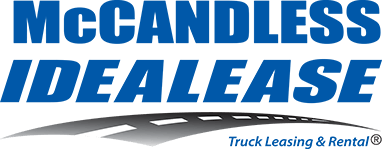Why Are We Getting Brake Adjustment Violations?
Read the latest Idealease safety bulletin "Why Are We Getting Brake Adjustment Violations?," below or access the entire bulletin here. Remember to sign up for the weekly bulletin and receive it directly in your inbox! Stay informed on the latest safety news, tips, and information! Need a PDF version to download and share?
Why Are We Getting Brake Adjustment Violations?
With automatic slack adjusters required by regulation on trucks and tractors since 1994 and trailers since 1995 why do we have brake adjustment violations? The first reason is that this is a mechanical device which if it is not maintained properly can malfunction and contribute to brakes out of adjustment. Slack adjusters on all commercial vehicles should be inspected and greased every 90 days.
Another reason is that a portion of these violations can be attributed to the technical working of the automatic slack adjuster. Professional drivers will maintain a space cushion between themselves and the vehicles in front of them. Then when applying the brakes, they will usually apply the brakes with 15% to 25% air application. A driver will only apply the brakes with greater than 60% air application in a defensive action. These braking incidents are called “Panic Stops” or “Rapid De-acceleration Occurrences.” The analysis reflects that most professional drivers will require less than six of these brake applications per 1,000 miles driven. Most of our Navistar trucks are equipped with a “Stroke Sensitive” automatic adjuster. This type of slack adjuster adjusts the brakes on the return stroke. This adjustment occurs only when the application is greater than 60%. The better the driver, the less opportunity there is for automatic brake adjustment. To ensure that the brakes are always in adjustment, we recommend the following:
- During your pre-trip inspection, complete 10 full brake applications while the unit is parked. A slack adjuster will adjust approximately ½ inch with every 10 full brake applications. Including this procedure as part of your pre-trip inspection will ensure that your brakes are always an adjustment. In the event of a roadside inspection, repeat this process before the inspection process. This will ensure that the automatic slack adjuster has adjusted the brakes to compliance.
- During the Pre-Trip inspection, a driver is required by the Federal Motor Carrier Safety Administration to check the low air pressure warning device.
This should be audible at 60 psi. The air pressure must be lowered to 60 psi to check this device. If, while accomplishing this portion of the inspection, a driver would fully apply and release, the air pressure should drop approximately four psi with each application.
Squeaking Brakes – Another condition attributed to “feathering or low psi” brake applications is noisy brakes when stopping. This is often created by crystallized lining, which occurs when the brakes are repeatedly applied with low psi. This can be minimized with four or five firm brake applications or rapid deacceleration stops. If your brakes are noisy, try bringing the vehicle to a stop with four or five firm brake applications weekly. Always check to see no vehicles following you when you perform this
procedure. Drivers who does not feel their brakes are operating normally must communicate this to their service provider on their daily vehicle inspection report. Drivers should NOT try and manually adjust automatic slack adjusters! A trained technician should only perform this.
Use the following links to access the Idealease Pre and Post-trip training videos:
English:
Tractor Trailer - https://youtu.be/9TL62H5yUQA
Straight Truck - https://youtu.be/rsUTQrN-514
Spanish:
Straight Truck – https://www.youtube.com/embed/SDvbuAuKQLM
Tractor Trailer- https://www.youtube.com/embed/529XGiJxTfU
February Is Heart Month: Are You at Risk for Heart Disease?
The perfect gift this Valentine’s Day is the gift of heart health. Along with Valentine’s Day, February marks American Heart Month, a great time to commit to a healthy lifestyle and make small changes that can lead to a lifetime of heart health.

Cardiovascular disease (CVD)—including heart disease, stroke, and high blood pressure—is the number 1 killer of women and men in the United States. It is a leading cause of disability, preventing Americans from working and enjoying family activities. CVD costs the United States over $300 billion yearly, including health care services, medications, and lost productivity.
Recognizing a Stroke
Sometimes symptoms of a stroke are difficult to identify. Unfortunately, the lack of awareness spells disaster. The stroke victim may suffer severe brain damage when people nearby fail to recognize the symptoms of a stroke.
Now doctors say a bystander can recognize a stroke by asking three simple questions:
S *Ask the individual to SMILE.
T *Ask the person to TALK and SPEAK A SIMPLE SENTENCE (Coherently) (i.e., It is sunny out today)
R *Ask him or her to RAISE BOTH ARMS.
If he or she has trouble with ANY ONE of these tasks, call the emergency number immediately and describe the symptoms to the dispatcher.
New Sign of a Stroke -------- Stick out Your Tongue Ask the person to ‘stick’ out their tongue. If the tongue is 'crooked', if it goes to one side or the other, that indicates a stroke.
https://www.cdc.gov/stroke/signs_symptoms.htm
PMTC Seeks Feedback on Enforcement of Canadian ELD Mandate
The private Motor Truck Council of Canada seeks input via a brief survey on the enforcement of the federal mandate for motor carriers and drivers in Canada to use Electronic Logging Devices. Beginning January 1, 2023, all carriers operating in Canada, including those based in the U.S., must meet the Transport Canada ELD requirements.
Unlike the U.S. ELD regulations, the Transport Canada rules require all ELDs to be certified by a third-party agency to comply with the devices' technical requirements.
*The Idealease Safety Bulletin is provided for Idealease locations and their customers and is not to be construed as a complete or exhaustive source of compliance or safety information. The Idealease Safety Bulletin is advisory in nature and does not warrant, guarantee, or otherwise certify compliance with laws, regulations, requirements, or guidelines of any local, state, or Federal agency and/or governing body, or industry standards.
